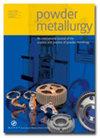Study of mechanical and tribological properties of Ti–6Al–4V alloy fabricated by powder bed fusion laser beam
IF 1.8
4区 材料科学
Q2 METALLURGY & METALLURGICAL ENGINEERING
引用次数: 1
Abstract
ABSTRACT Powder bed fusion laser beam, as one of the most promising forming technologies, offers unmatched benefits over traditional processing, particularly in the production of Ti–6Al–4V. The influence of laser line energy density (LLED) on the forming surface, phase composition, micro-hardness, tensile characteristics and wear resistance of Ti–6Al–4V alloy were explored to disclose the evolution of mechanical and tribological properties. According to the findings, the LLED causes ‘depressions’ and ‘highlands’ between nearby scanning tracks. The phase composition did not alter appreciably as LLED increased. Micro-hardness and tensile characteristics increased initially, then declined, and the value of maximum micro-hardness and ultimate tensile strength were 388.17 HV0.2 and 1197.5 MPa, respectively. Furthermore, when the LLED is 0.24 J mm–1, the wear resistance is optimal under the aviation lubricant medium, with an average friction coefficient of 0.1505 and volume wear rate of 6.95∗10−8 mm2∗N−1, and a wear mechanism of mild furrow wear and adhesion wear.粉末床熔融激光束制备Ti–6Al–4V合金的力学和摩擦学性能研究
摘要:粉末床融合激光束作为最有前途的成形技术之一,与传统工艺相比,具有无与伦比的优势,尤其是在Ti–6Al–4V的生产中。探讨了激光线能量密度(LLED)对Ti–6Al–4V合金成形表面、相组成、显微硬度、拉伸特性和耐磨性的影响,揭示了其力学性能和摩擦学性能的演变。根据研究结果,LLED会导致附近扫描轨道之间出现“凹陷”和“高地”。随着LLED的增加,相组成没有明显变化。显微硬度和拉伸特性先增加后下降,最大显微硬度和极限拉伸强度分别为388.17HV0.2和1197.5 MPa。此外,当LLED为0.24 J时 mm–1,在航空润滑介质下的耐磨性最佳,平均摩擦系数为0.1505,体积磨损率为6.95*10−8 mm2*N−1,磨损机制为轻度沟槽磨损和粘着磨损。
本文章由计算机程序翻译,如有差异,请以英文原文为准。
求助全文
约1分钟内获得全文
求助全文
来源期刊

Powder Metallurgy
工程技术-冶金工程
CiteScore
2.90
自引率
7.10%
发文量
30
审稿时长
3 months
期刊介绍:
Powder Metallurgy is an international journal publishing peer-reviewed original research on the science and practice of powder metallurgy and particulate technology. Coverage includes metallic particulate materials, PM tool materials, hard materials, composites, and novel powder based materials.
 求助内容:
求助内容: 应助结果提醒方式:
应助结果提醒方式:


